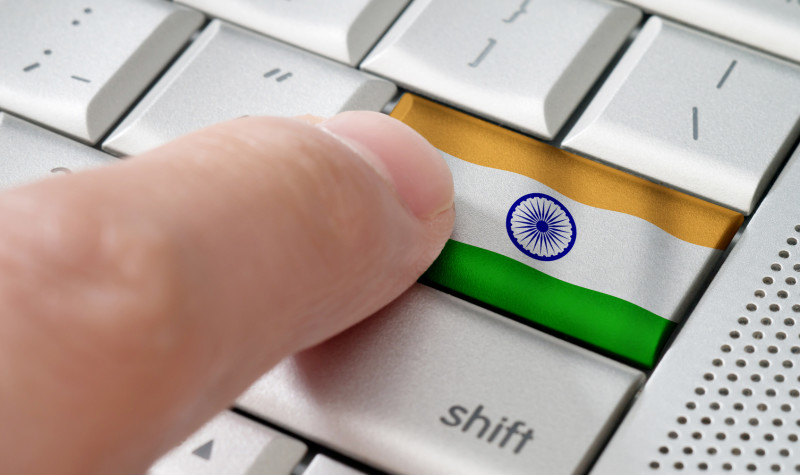Smartphone Politics: How technology is shaping the Indian election

Smartphones have emerged as the key battleground in the current Indian general election. Could politics reverse the secular decline in smartphone sales? Victor Hill investigates.
Narendra Modi calling
Some politicians follow the trend – but a few lead it. The Indian Prime Minister, Narendra Modi, who is expected to be re-elected at the conclusion of the Indian general elections on 19 May, has developed his own smartphone app.
In the run-up to the last general election in 2014 voters in Uttar Pradesh, India’s largest state with over 200 million inhabitants, began receiving daily calls on their mobile phones. When they answered they heard the recorded voice of Narendra Modi, then the leader of the opposition Bharatiya Janata Party (BJP – often translated into English as the Hindu Nationalist Party, though Bharatiya means Indian and Janata means populace in Sanskrit).
| Master Investor Magazine
Never miss an issue of Master Investor Magazine – sign-up now for free! |
A known technophile, Mr Modi was anxious to use every channel of communication in order to disseminate his message to the people of India. He was the first senior Indian politician to use technology widely in election campaigning – and it worked.
This time around Mr Modi is chasing the votes of over 900 million Indians on the electoral roll in a contest which is regarded as a plebiscite on his last five years in power. Indian politicians now regard the key channel of communication in the election as the smartphone. That is partly because almost every Indian family – all but the very poorest – have access to a smartphone. In 2017 there were about 300 million smartphones in use in India out of a total population of 1.2 billion – so one in four citizens used one.
Indian politicians in rural areas used to try to bribe voters by giving them a goat. Nowadays, things are a little more sophisticated. These days, voters are being bamboozled with millions of free smartphones. In the state of Chattisgarh, which has a population of 25 million, some five million smartphones have been donated to prospective voters for free, according to Hasan Chowdhury[i].
Since 2014 both smartphone usage and internet connections have exploded in India – from about 20 million connections to 450 million today. The majority of Indians access the internet via their smartphones. This has precipitated a price war between mobile phone networks resulting in a significant fall in phone charges.
Mr Modi is, like the President of the USA, a regular and outspoken user of Twitter (NYSE:TWTR). While Mr Trump is the most followed leader on Twitter with 60 million followers, Mr Modi comes in at number three with an impressive 43.4 million followers. (Pope Francis occupies the number two slot with 47 million followers).
But Mr Modi has been judged the world’s most effective world leader on Facebook (NASDAQ:FB) with each of his posts eliciting about 100,000 responses. His official page on Facebook has been “liked” by over 43 million people[ii]. Even the official Facebook page of the Indian Prime Minister’s Office (PMO India) has been “liked” by over 13 million people. On photo-sharing platform Instagram (owned by Facebook), Mr Modi tops the chart of the 50 most liked world leaders with 12 million followers.
But what is unique is that Mr Modi has made available a mobile phone app to his supporters, known in India as the NaMo app, by means of which they can keep abreast of all his latest pronouncements and policy initiatives. The NaMo app has been downloaded by 10 million users and also comes pre-installed on all phones provided by telecoms giant Reliance Jio. Jio has nearly 300 million subscribers and is a subsidiary of conglomerate Reliance Industries Ltd (BSE:500325). Based in Mumbai, Reliance, which is the largest company by market capitalisation on the Mumbai market, is ultimately controlled by India’s richest man, Mukesh Ambani.
Users who access the NaMo app are first greeted by an image of the bearded Mr Modi who is always tie-less, but wearing a brightly coloured waistcoat in the traditional Indian style. The image then invites users to participate in the noble project of nation building. There follows a menu of news items with a strong slant to the BJP’s Hindu nationalist perspective. On Jio phones, where it is pre-installed, users cannot delete it. (That’s not unique: on Android-powered smartphones Google cannot be deleted!).
The NaMo app has been criticized by opposition parties as a weapon of propaganda wielded by the BJP. Maybe that is sour grapes: clearly opposition parties are finding it difficult to compete with the BJP’s mastery of social media which is being coordinated by over one million activists. There is, however, a growing body of opinion that the NaMo app is actually being used to disseminate fake (or let us just say, inaccurate) news. (For example, one post on the NaMo app claimed that nearly all rapes in India were perpetrated by Muslims – a claim that is demonstrably false).
Another accusation is that the NaMo app has traded user data with third parties without their permission. The BJP denies this but Congress Party leader Rahul Gandhi has scorned Mr Modi as “the big boss who likes to spy on Indians”.
Like all Western democracies, India has an election watchdog – but it has proven challenging for that body to police social media. What is required, as elsewhere, is a comprehensive rulebook to which everyone subscribes.
WhatsApp in India
WhatsApp (also owned by Facebook) has over 200 million users in India. It recently set out measures that it would take to combat abuse. This is particularly sensitive as posts on WhatsApp have been blamed for inciting lynchings and public disorder. India’s delicate interlinking membranes of caste, language and ethnicity have proven highly sensitive to inappropriate content on social media. The majority of the so-called WhatsApp lynchings have occurred in remote village locations and have been perpetrated against vulnerable people and minorities accused of such things as child abduction.
Contrast with China
India is likely to overtake China within the next three years as the most populous nation. Both countries currently have approximately 1.3 billion inhabitants. Both are large ancient nations which can be termed civilisation states. But India is a pluralist democracy with the rule of law deeply embedded while China is a single-party state with totalitarian tendencies. The Indian ruling party can and does get kicked out from time to time.
In China, the Communist Party now has more than 100 million smartphone users who follow its every pronouncement by means of a state-controlled news app called Xuexi Qiangguo. This has become the most downloaded app on the Chinese branch of the Apple Store.
Smartphone saturation
In 2018 it became clear that, globally, smartphone sales are in decline. Sales of Apple’s iPhone fell by 2.7 percent to 209 million units. Earlier this year, Apple cut its sales forecasts for the first time since 2002 (a year when it did not produce smartphones at all). Essentially, the smartphone market is saturated – almost everyone in the developed world who wants one already has one, so the main motivation for purchase is to upgrade to new models.
| Master Investor Magazine
Never miss an issue of Master Investor Magazine – sign-up now for free! |
That said, about 1.2 billion smartphones were sold across the world last year, meaning this is still a colossal market worth easily a trillion dollars a year. That market is dominated by just a handful of giants: Apple (NASDAQ:AAPL), Samsung (KRX:005930) and Huawei (SHE: 002502); followed somewhat behind by Google (NASDAQ:GOOG) (in partnership with Foxconn (TPE:2354)), Sony (TYO:6758), Nokia (HEL:NOKIA) and LG (KRX:066570). Interestingly, the leading smartphone brands in India are Samsung and Xiaomi (HKG:1810) of China.
Last September, Apple unveiled the 13th generation of its iPhone. Since the first generation iPhone was launched in 2007 it has sold around 1.5 billion devices. An estimated 800 million people around the world use an Apple smartphone. The largest part of Apple’s revenues come from Smartphone sales which is why it is desperately trying to diversify into other revenue streams including entertainment, wearables, accessories and software downloads.
The good news for smartphone manufacturers is that users will most likely have to upgrade in order to access the new super-fast 5G infrastructure which will be rolled out in many countries over the next three years. Significantly, Apple has not yet produced a model tailored for 5G.
As smartphones become essential in public policy, for example in monitoring people’s health, it is likely that governments will wish to interact with citizens via their smartphones more pro-actively. In the UK the ambitions of Health Secretary Matt Hancock to digitise the NHS points to patients being issued with smartphones. I can easily foresee that teens in the UK might be issued with smartphones at school pre-installed with apps to reinforce their curriculum learning. That would be good news for smartphone manufacturers.
2019: The year of elections
For election lovers this is proving a bumper year. The Israelis re-elected Mr Netanyahu (just) on 09 April. Last Sunday (21 April) the Ukrainians elected an actor who had never held political office to be the President of their troubled nation. India is already at the polls (as discussed above). The Spanish will vote for a new Cortes this coming Sunday (28 April). South Africans vote in a general election on 08 May. Australia votes for a new parliament on 18 May. The European Union (almost certainly now including Britain) will elect a new European Parliament between 23 and 26 May. Denmark has a general election on 17 June.
Social media will play a key role in all these elections – and it makes their outcomes more uncertain. Political parties which deploy activists who understand how to use social media effectively wield a particular advantage.
In the UK general election of June 2017 Labour emerged hands-down as the most effective player in cyberspace, mobilising large numbers of young people who might otherwise have not voted at all. (And the overwhelming majority of those millennials access the internet via their smartphones.) The Tories have shown no signs of having learnt the lessons of that election. And, with a cohort of despairing and indignant activists, the Tories are, in any case, not in a fit state to run an election campaign at all.
Mr Farage’s political start-up, the Brexit Party, in contrast, has within a month or so of its launch, demonstrated a vice-like grip on social media. I would not be surprised if Mr Farage’s strategists are studying Mr Modi’s app closely. Watch this space.
[i]See Long March of smartphones is changing the face of politics, by Hasan Chowdhury, The Daily Telegraph, 17 April 2019.
[ii]See: https://www.livemint.com/Politics/d9msMK13chc6bwTFyWkMNO/PM-Narendra-Modi-is-world-No-3-on-Twitter-No1-on-Facebook.html

Comments (0)